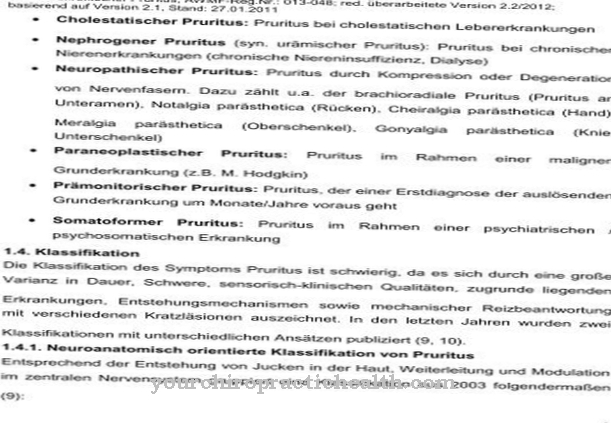As De Barsy Syndrome is a congenital disease that brings a number of physical and mental ailments with it. Therapy focuses on treating the symptoms.
What is De Barsy Syndrome?

© Sondem - stock.adobe.com
De Barsy syndrome is one of the diseases of progeria. This means “premature aging”, which can also be seen in the symptoms. This leads to mental retardation, pale skin, weakened joints and various visual impairments. The latter are usually associated with corneal opacity and, like the other symptoms, are difficult to treat.
There are now some medications that increase life expectancy but cannot treat the cause. The preventive measures are also limited to a minimum, since the congenital defect arises from spontaneous mutation and usually only becomes noticeable after birth. The actual treatment therefore focuses on operations that, for example, improve eyesight or stabilize the joints.
causes
De Barsy syndrome, also called De Barsy Moens Dierckx syndrome, is congenital and cannot therefore be clearly traced back to a cause. It is assumed, however, that a change in the genome is responsible for the development.
More precisely in the so-called Lamin A / C gene, which is responsible for the production of two proteins - Lamin A and Laminc C. These in turn strengthen the cell body envelope and are involved in cell division. In De Barsy syndrome, the gene is defective, which disrupts the processes mentioned. The development that leads to the change in the genetic make-up is purely coincidental and usually occurs without prior disease in the parents.
This spontaneous mutation makes treatment and prevention extremely difficult. Determining the symptoms is also a tedious task due to the diversity of De Barsy syndrome.
Symptoms, ailments & signs
De Barsy syndrome is associated with a number of distinct symptoms. This can lead to various skin symptoms such as itchy skin and a skin lesion. In addition, in many cases a cranial bladder develops, i.e. an accumulation of fluid under the skin layers. Eczema, rashes and acne can also occur.
In the area of the eyes, foggy vision, blurred vision or even complete loss of vision can occur. Hip dislocations without recognizable causes, short stature or protruding ears are less common.
Outward signs of De Barsy syndrome include downward sloping eyelids, a small mouth, and a wide, relatively flat bridge of the nose. Furthermore, there are hyperextensible joints, increased tendon reflexes and growth retardation. These symptoms already appear in the womb and are often associated with reduced mental development.
In childhood, the disease can be recognized by large fontanelles, corneal opacities and cataracts. Due to the diversity of possible symptoms and complaints, a clear assignment of the disease is only possible through a comprehensive diagnosis.
Diagnosis & course
The diagnosis of De Barsy syndrome is made through a variety of tests. First, a medical history is taken with the patient or a parent to get into the details. Among other things, it is determined which symptoms appear and since when they have appeared, as well as the general state of mind of the patient.
Pre-existing diseases or genetic defects in the family are also identified during this interview and included in the examination. If the doctor already has a specific suspicion based on the anamnesis, a skin biopsy is usually performed. Here, a tissue sample is taken from the skin and dermatopathologically assessed.
Depending on the type and severity of the disease, either a simple punch biopsy or a more complex incisional biopsy can be performed. From this point on, blood tests and a CT scan can be carried out, on the one hand to rule out other diseases and on the other to determine the severity of De Barsy syndrome.
The course of the disease in De Barsy syndrome is usually negative.If the disease is detected early, eye operations and physiotherapeutic measures can be carried out to correct the defects. Nevertheless, those affected usually have a lower quality of life due to their restricted mobility and reduced eyesight.
In the meantime, however, there are some drugs that have been specially developed for the treatment of De Barsy syndrome and target known symptoms such as narrowed blood vessels and weak bones.
When should you go to the doctor?
If symptoms such as itchy skin, rashes, and other signs of De Barsy syndrome are noticed, a doctor is recommended. In childhood, the disease is also noticeable through large fontanelles, corneal opacities and a cataract.
Parents who notice symptoms in their child should speak to their pediatrician or family doctor immediately. Depending on the symptoms, a specialist in hereditary diseases, an ophthalmologist or an orthopedist can also be consulted. In the event of an accident or fall due to the malformation, it is best to contact the emergency medical service.
In the best case scenario, the affected child is taken directly to the nearest hospital. De Barsy syndrome must always be clarified by a doctor and treated if necessary. The child usually needs support with everyday tasks from an early age. If there are signs of emotional distress - for example if the child is bullied in kindergarten or school - a psychologist should also be called in.
Doctors & therapists in your area
Treatment & Therapy
Treatment for De Barsy syndrome focuses on symptoms. In order to avoid contractures, for example gymnastic and physiotherapeutic measures are initiated. The eyesight can also be strengthened through various measures such as operations or, in an advanced stage, through a visual aid. In addition, special drugs, so-called bisphosphonates, are used.
These strengthen the bones and joints and thus prevent the fractures and contractures mentioned. Depending on the severity of the disease, acetylsalicylic acid can also be prescribed. The remedy prevents blood clots and thus prevents heart attacks and strokes, which can significantly extend life expectancy.
The actual cause of De Barsy syndrome cannot yet be treated. However, it is possible to contain the disease with early treatment and a few preventive measures.
Outlook & forecast
As a rule, De Barsy syndrome cannot be treated causally because it is a congenital disease. The patients are therefore always dependent on symptomatic therapy in order to alleviate the symptoms and thus also improve the quality of life.
If De Barsy syndrome is not treated, people will suffer from various skin conditions. In many cases, these lead to inferiority complexes or a reduced self-esteem, whereby children can also suffer from bullying or teasing. Often this also leads to psychological upset or depression. There is also a clearly delayed development of the patient and mental retardation.
Treatment of De Barsy syndrome is therefore primarily based on the skin complaints and delayed development. With the help of ointments and creams, the skin problems can usually be alleviated well. The mental development can also be alleviated by intensive support. However, complete healing does not occur here, so that those affected are always dependent on the help of other people in their everyday lives. As a rule, De Barsy syndrome does not reduce life expectancy.
prevention
Since De Barsy syndrome is congenital, the onset of the disease cannot be prevented. However, it is possible to become aware of the syndrome through a prenatal examination and to prepare the necessary measures. The baby can then be operated on relatively soon after birth and given various medications.
This also includes drugs that contain a special farnesyl transferase inhibitor, which makes the blood vessels more elastic. This can potentially extend the life expectancy of the sick person.
Aftercare
In the case of De Barsy syndrome, in most cases there are very few follow-up measures available to those affected. Since this disease is a congenital disease, it cannot be treated completely, so that follow-up care always refers to purely symptomatic treatment. However, a doctor should be contacted at the first signs and symptoms of this syndrome in order to prevent further symptoms.
If the person concerned wants to have children, genetic counseling can also be useful in order to prevent the disease from recurring. In most cases, De Barsy syndrome is treated with medication. The person affected should ensure that they are taken regularly and that the medication is administered correctly. If you have any questions or are unclear, you should always contact a doctor first.
Since the disease also significantly increases the likelihood of a heart attack, the heart should be examined regularly by a doctor. In general, a healthy lifestyle with a healthy diet has a very positive effect on the further course of this disease. It cannot be universally predicted whether De Barsy syndrome will lead to a reduced life expectancy for the person affected.
You can do that yourself
De Barsy syndrome is a congenital disease, the causes of which are not yet fully understood. The sufferer cannot take steps to treat the syndrome causally.
The external features of the disease, including downwardly directed eyelids, protruding ears, a small or deformed mouth and often a very wide and flat bridge of the nose, can usually be corrected with the help of plastic surgery.
The short stature that can often be observed is often associated with hyperextensible joints and increased tendon reflexes. Physiotherapy started early can help to build up muscles in a targeted manner to support the affected joints. In this way, the patient's mobility is continuously improved and maintained. If mobility remains restricted, the patient should learn how to use walking aids at an early stage.
Reduced eyesight cannot always be completely corrected with visual aids. Depending on the extent of the visual impairment, it can be helpful if the patient gets used to using a white cane or other aids in good time.
However, De Barsy syndrome not only affects physical development. Very often those affected are also mentally disabled, although the extent of the disability can vary widely. In any case, parents should pay attention to optimal early intervention in order to give their child the best possible educational support.

.jpg)

.jpg)























